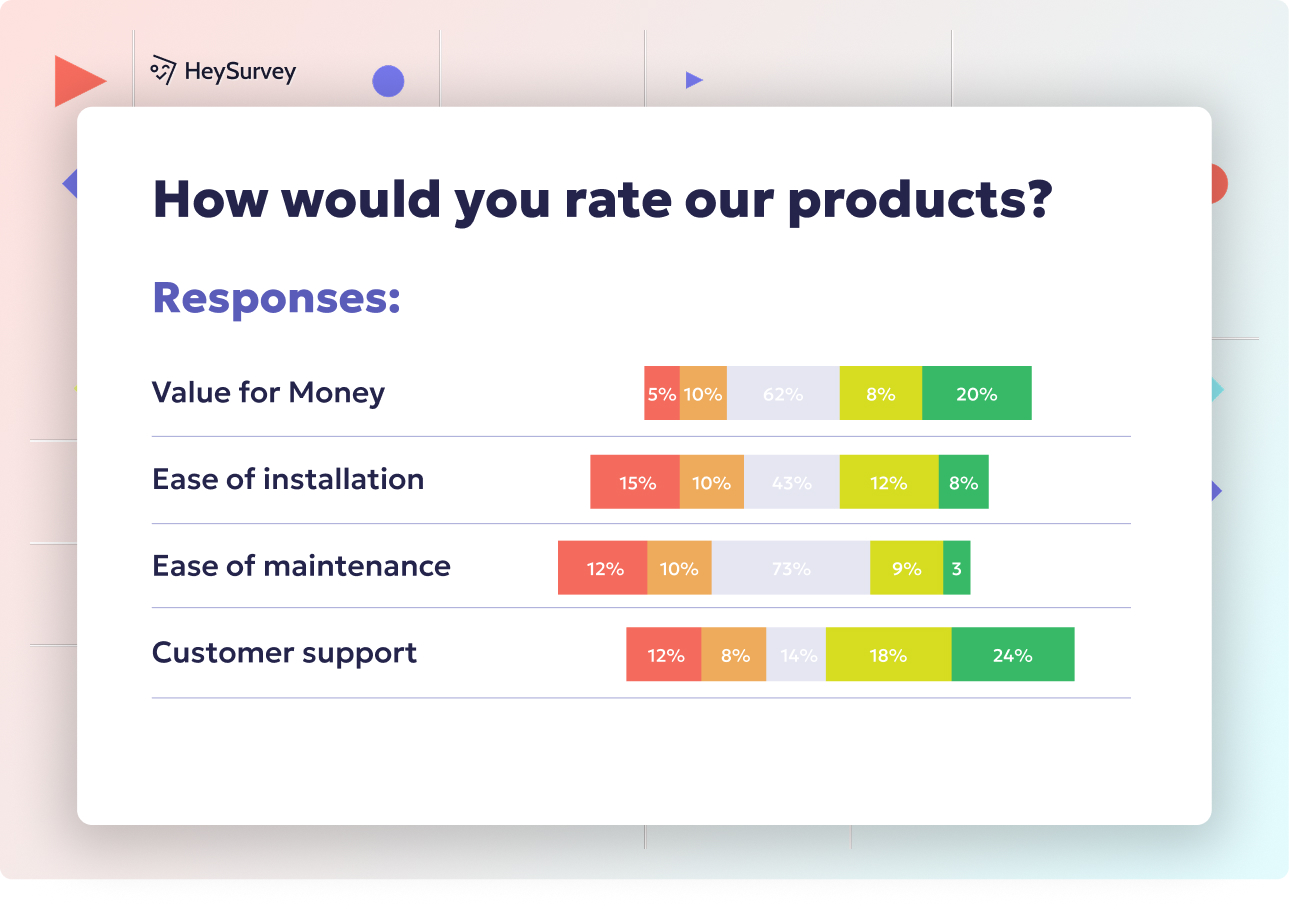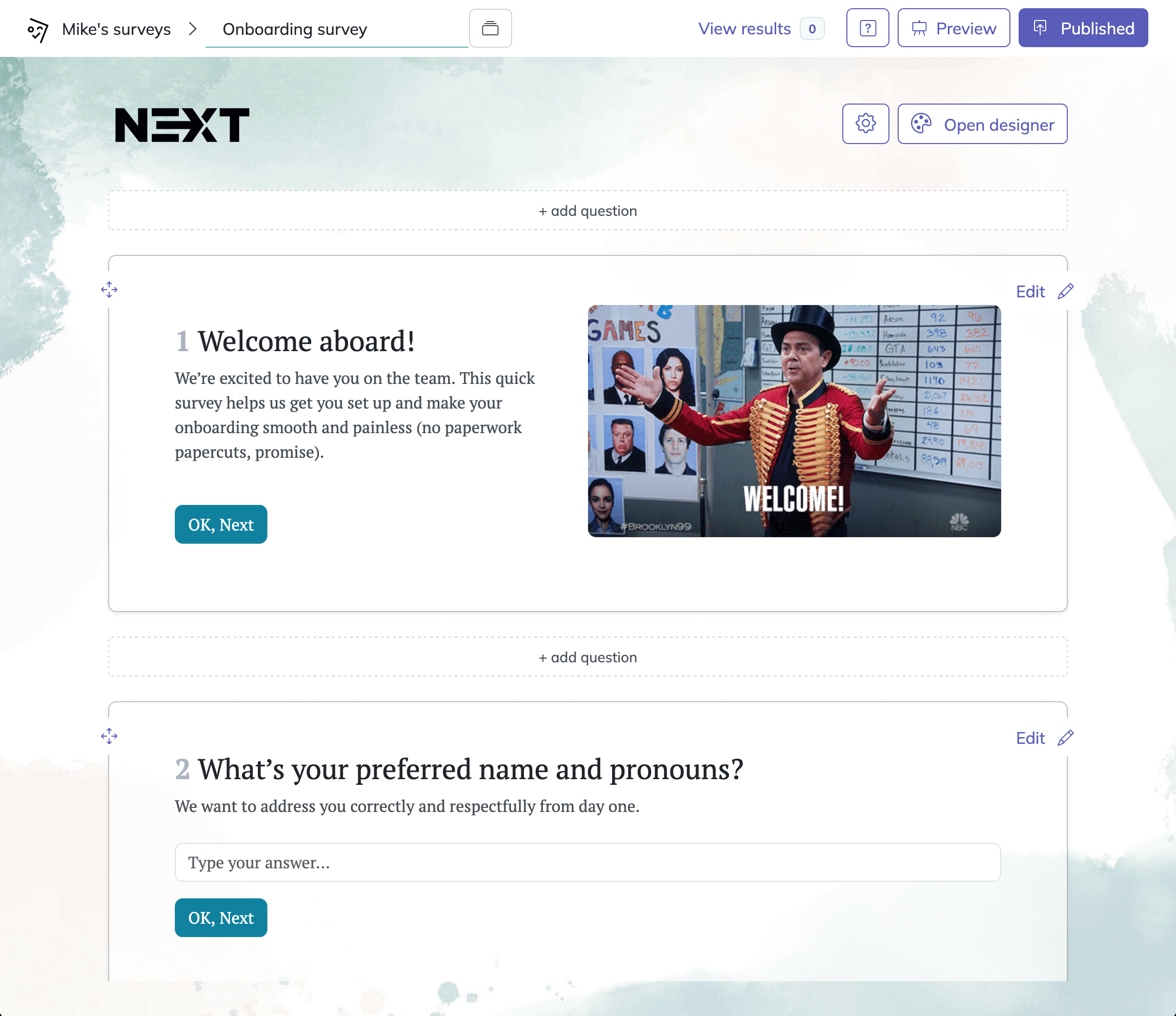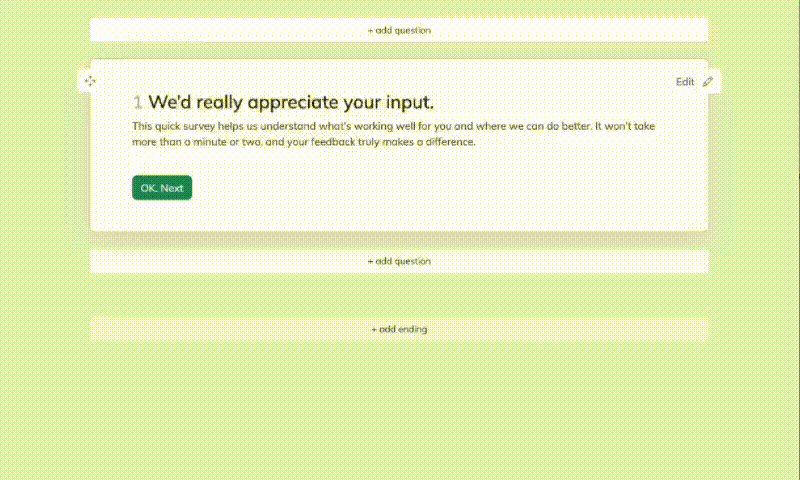30 Internal Customer Service Survey Questions to Boost Engagement
Explore 30 expert internal customer service survey questions with tips to boost employee engagement, collaboration, and service quality.
A thriving business doesn’t just serve external customers—it keeps its internal customers just as happy. Internal customers are anyone inside the organization: employees, departments, or locations depending on each other to get work done. Their day-to-day experiences can make or break your brand’s quality and reputation. When their needs go unmet, friction points multiply—impacting everything from speed to innovation. Smart companies launch internal customer service surveys to locate trouble spots, fine-tune training, and build a service-driven mindset. Below, you’ll find a guide to the most useful survey types, complete with insights and ready-made questions that make feedback a breeze.
Employee Satisfaction & Engagement Survey
Why & When to Use This Survey Type
If you want to create a work environment where people stick around, you have to know how they’re feeling. The internal employee satisfaction survey questions dig into the heart of teams: Do they feel heard and valued? Is their workload doable or off the rails? This pulse check comes in handy after big changes, tough quarters, or on a routine basis (think every quarter).
Deploying an engagement pulse survey helps you catch morale dips before they create domino effects. The earlier you get wind of issues, the quicker you can respond—no guessing needed. When major shifts occur, such as new leadership or policy changes, even the most optimistic folks can feel uncertain.
Focusing on satisfaction and engagement isn’t just about happy faces in the hallway. These insights guide managers to better recognize hard work, spark meaningful growth conversations, and prevent burnout. If your team feels overlooked or overwhelmed, they’re less likely to pass on great service to their coworkers—or external customers. Regular surveys spotlight what’s working (and what’s not) so fixes aren’t a shot in the dark.
Here’s why you’ll love these surveys:
They reveal early warning signs before turnover rises.
They show leaders where to direct praise or improvement efforts.
They support a culture of trust, with everyone’s voice counting for something.
Five Sample Questions
How supported do you feel by your manager and coworkers in your daily work?
Do you feel your current workload is manageable most days?
How often do you receive recognition for work well done?
Do you see meaningful growth or learning opportunities here?
Overall, how satisfied are you with your experience working at this organization?
A study found that internal customer service quality significantly influences internal customer satisfaction, which in turn affects external customer satisfaction. (researchgate.net)

Creating your internal customer service survey with HeySurvey is as easy as 1-2-3. Here’s how you can get started and have your valuable feedback flowing in no time:
Step 1: Create a New Survey
Head to HeySurvey and either log in or start without an account if you want to test it out first.
Choose “Create Survey” and then pick from the available options:
- Use an Empty Sheet to start totally fresh.
- Grab a useful Pre-built Template tailored for internal surveys (you can open one right below these instructions with the button!).
- Or try Text Input Creation by typing your questions directly and letting HeySurvey format it for you.
- Use an Empty Sheet to start totally fresh.
Give your survey a clear internal name to keep things organized.
Step 2: Add Your Questions
Hit “Add Question” inside the Survey Editor to start building your question list.
Select the best question types for your needs — like Likert Scale for rating support or Choice questions for specific options.
Fill in your question text and tweak settings such as requiring answers or adding images to make things lively.
Use branching logic if you want to send respondents down different paths based on their answers—perfect for customizing their experience.
Step 3: Publish and Share Your Survey
Once you’re happy with your questions and design, click “Preview” to see how it looks from a respondent’s view.
Customize branding by uploading your logo and adjusting colors in the Designer Sidebar to keep the survey on brand.
Set up survey options through the Settings Panel: add start/end dates, response limits, or a completion redirect link.
When ready, hit “Publish” to get your shareable link or embed code.
Bonus Step 4: Apply Branding and Custom Design
Open the Designer Sidebar to:
- Upload your logo and change colors or fonts.
- Add background images or tweak layouts for a professional and engaging look.
- Upload your logo and change colors or fonts.
Pick one question per page or multiple per page layouts to control how respondents experience your survey.
Bonus Step 5: Define Advanced Settings or Branching
Use the Settings Panel to:
- Schedule your survey availability and limit responses.
- Allow respondents to view results if suits your feedback loop.
- Schedule your survey availability and limit responses.
Implement branching to guide users through different questions based on their previous answers, making the survey smarter and more relevant.
Ready to start? Click the button below to launch a pre-built internal customer service survey template and customize it with these steps to suit your organization's unique needs!
Service Quality & Responsiveness Survey
Why & When to Use This Survey Type
Measuring the quality of internal service can turn a series of “meh” interactions into moments that shine. When you update service level agreements or set new standards, it’s the best time to measure how well your internal teams are delivering.
Are requests handled quickly, or does every ticket feel like it’s in limbo? That’s where an internal service quality questionnaire comes in. Timing is everything—right after rolling out changes, send a survey while the experience is fresh. Make it a regular check so you don’t build up blind spots.
A good responsiveness survey uncovers snags like slow replies, missed details, or robotic responses. When internal customers are forced to dwell in ambiguity, overall productivity takes a nosedive. Raising the bar on service quality within the organization means less back-and-forth, fewer repeated requests, and higher trust.
Here’s what makes these surveys especially valuable:
Requests for help often outnumber the people providing it—measure responsiveness to avoid staff burnout.
Fast and accurate responses keep projects moving and reduce stress.
Clarity and courtesy show employees they matter, not just their work output.
Five Sample Questions
How would you rate the speed of response to your requests?
Was your issue or inquiry resolved on the first attempt?
Did you receive clear and accurate information from the service team?
How empathetic and courteous was the service you received?
Overall, how would you rate the quality of internal service provided?
Research indicates that internal customer satisfaction surveys should include clear goals, relevant questions, and a mix of quantitative and qualitative data to effectively measure service quality. (gretaforag.com)
Interdepartmental Collaboration Survey
Why & When to Use This Survey Type
Any organization with more than one team knows cross-functional friction is real. The cross-department survey shines a light on how easily teams share information, solve problems together, and chase after common goals. Run this survey during large initiatives or after major projects, when lessons are still fresh and raw.
Think of the internal collaboration feedback survey as your ultimate reality check. Are teams truly aligned, or does it feel like herding cats? Honest feedback here keeps teams from working at cross-purposes, which only creates chaos for everyone involved.
Focusing on collaboration isn’t just warm and fuzzy talk. When teams work well together, projects finish faster, budgets stay in check, and the work is just plain more fun. On the flip side, if information gets stuck or teams see each other as rivals, customers (both internal and external) sense the disconnect.
Here’s why you’ll want to keep tabs on collaboration:
Shared goals turn rival departments into winning teams.
Healthy info flow means fewer surprises and urgent fire drills.
Early conflict resolution stops issues before they become costly.
Five Sample Questions
How easy is it to collaborate with other departments on shared tasks or projects?
Do you feel information flows smoothly between your team and others?
When conflicts arise between teams, how well are they resolved?
Do you clearly understand and support the shared goals between departments?
What one improvement would you suggest to strengthen cross-department collaboration?
Internal Help Desk Experience Survey
Why & When to Use This Survey Type
Every workplace needs a hero, and sometimes that hero is your IT help desk or facilities support. Measuring internal support feedback immediately after a ticket closes gives you the real scoop—no memories fading, no details missed. It’s the best way to keep a bead on what really happens from the user’s perspective.
An IT help desk survey is most powerful when sent within hours of ticket closure, while gratitude (or lingering frustration) is fresh. Make sure these surveys are routine—one-off check-ins won’t catch recurring issues or highlight your star agents.
If employees dread asking for help, you’ll see workarounds that can cause more problems than solutions. Measuring internal service feedback regularly helps tech and facilities teams keep pace with needs, track their performance, and spot training opportunities.
You’ll want these insights because:
Fast, expert help is the backbone of productivity.
Satisfied users mean fewer follow-up tickets and less duplication.
Feedback here builds a continuous improvement loop for the help desk team.
Five Sample Questions
How easy was it to submit your request or ticket?
Did the support agent demonstrate the needed expertise to resolve your issue?
Was your problem resolved in a timely manner?
How clear and proactive was the communication from support?
Overall, how satisfied are you with the help desk experience?
Implementing internal customer satisfaction surveys with clear goals and relevant questions enhances service quality and employee engagement. (gretaforag.com)
Training & Knowledge Resources Survey
Why & When to Use This Survey Type
Even the happiest teams hit bumps when the training resources or company knowledge bases miss the mark. Launch a survey after onboarding or when rolling out new processes to see if resources keep up with real-life challenges. Don’t wait until complaints pop up—get ahead with an internal training feedback survey.
When your knowledge base evaluation questionnaire uncovers missing or outdated info, you can act fast. Employees who have what they need—when and how they need it—will make fewer mistakes and feel less frustrated. Don’t forget format! Some learn best by video, others by step-by-step guides or interactive demos.
Training and resources can make or break a new hire’s first few months, and they smooth out change for seasoned pros too.
Benefits of evaluating your resources regularly:
Find and fix knowledge gaps before they spread.
Tailor learning formats to fit diverse learning styles.
Build a culture of continuous improvement by responding to real feedback.
Five Sample Questions
How easy is it to access the training and knowledge resources you need?
How relevant and up-to-date are the materials provided?
Do you feel the resources cover topics in enough detail for your role?
What format do you prefer for training and learning materials (video, written, interactive)?
What additional topics or resources would help you perform better?
Change Readiness & Support Survey
Why & When to Use This Survey Type
Software migrations, organizational shake-ups, new workflows—change is the only constant. Sending a change management survey measures how employees really feel, so you can ditch the guesswork and make adjustments on the fly. Timing is key: survey at big milestones, whether before, during, or after a change.
An internal readiness assessment reveals where employees need more support, clarity, or resources. If you don’t ask, expect resistance or confusion to show up as mistakes, missed deadlines, or even turnover. Good survey results signal when it’s safe to move ahead—or when the change management plan needs tweaking.
Smart organizations know that listening during transitions is a superpower. You’ll spot hidden roadblocks, bust rumors, and guide leaders to communicate better every time.
Why use change readiness surveys?
Spot resistance early and adapt your communication strategy.
Tailor training and resources by department or location needs.
Measure confidence so you don’t push big moves before teams are ready.
Five Sample Questions
How well do you understand the reasons for the upcoming change?
How confident are you in leadership to manage this transition effectively?
Do you feel you have the resources and support needed to adapt to the change?
What challenges do you anticipate during the transition?
What improvements or additional support would help you feel more prepared?
Leadership Communication & Alignment Survey
Why & When to Use This Survey Type
Clear communication from the top isn’t just nice—it’s crucial for connecting employees to the company’s mission and each other. A leadership communication survey dives deep into how messages are delivered and received, and what’s getting lost along the way. Run this survey after town halls or major strategic rollouts to track alignment.
The internal alignment feedback measures how well employees know the company vision and how much they trust leadership to deliver. If leaders are talking only to each other, you’ll see confusion and detachment among teams. Semi-annual check-ins ensure the message is getting through and creating motivation, not just more noise.
Teams unified behind a vision deliver better service every time.
Here’s why these surveys are mission-critical:
Spot and fix gaps in understanding before they grow.
Build trust by offering a true feedback loop—not just a one-way broadcast.
Align everyone on goals so service is consistent at every level.
Five Sample Questions
How clearly do you understand the organization’s vision and goals?
How accessible are leaders when you have feedback or questions?
Do you feel your input is heard and acted upon by leadership?
How transparent is leadership when sharing information about company performance and change?
How much do you trust company leaders to make decisions that benefit employees and customers?
Best Practices: Dos and Don’ts for Internal Customer Service Surveys
Creating effective internal customer service surveys is both an art and a science. Even a great set of questions can fall flat without the right approach. Here’s what you should do to maximize engagement and actionable insights:
Keep surveys brief so they’re easy to complete—ideally under 10 minutes.
Align survey questions with key organizational KPIs to track real impact.
Guarantee anonymity to ensure honest and open feedback.
Always close the feedback loop by sharing results and upcoming action plans with respondents.
Regularly benchmark results both over time and against industry standards.
On the flip side, there are a few pitfalls to dodge:
Don’t flood teams with jargon or complicated wording that muddies the meaning.
Avoid survey fatigue by choosing your timing carefully—too many or too few surveys both hurt participation and data quality.
Never ignore rich, qualitative comments; they’re often more revealing than numbers alone.
Don’t rely solely on one distribution channel, or you’ll miss key voices.
Don’t wait too long to act on survey findings—swift action builds trust.
Statistically, organizations that survey and respond to feedback see up to 14% higher employee engagement scores. And in the real world, consider companies like Google or Zappos that famously use internal feedback to continuously tweak their processes, leading to higher employee loyalty and better customer experiences.
Keep your survey process nimble, transparent, and centered on improvement—your teams (and your customers) will thank you!
Conclusion
Building a robust internal survey strategy turns daily frictions into launchpads for improvement. By listening to employees, acting quickly, and sharing progress, you’ll foster a happier, more engaged workplace and deliver service that sets you apart. Mix question types for depth, revisit results regularly, and celebrate wins as they come. When organizations invest in their people’s voices, everyone grows—inside and out.
Related Employee Survey Surveys

29 Essential Post Mortem Survey Questions for Project Success
Discover 25+ essential post mortem survey questions to improve projects, boost team morale, and d...

31 Change Readiness Survey Questions to Boost Your Success
Discover 25+ sample change readiness survey questions to assess attitudes, barriers, and confiden...

31 Retreat Survey Questions to Collect Actionable Feedback
Discover 26 essential retreat survey questions to gather actionable feedback before, during, and ...
